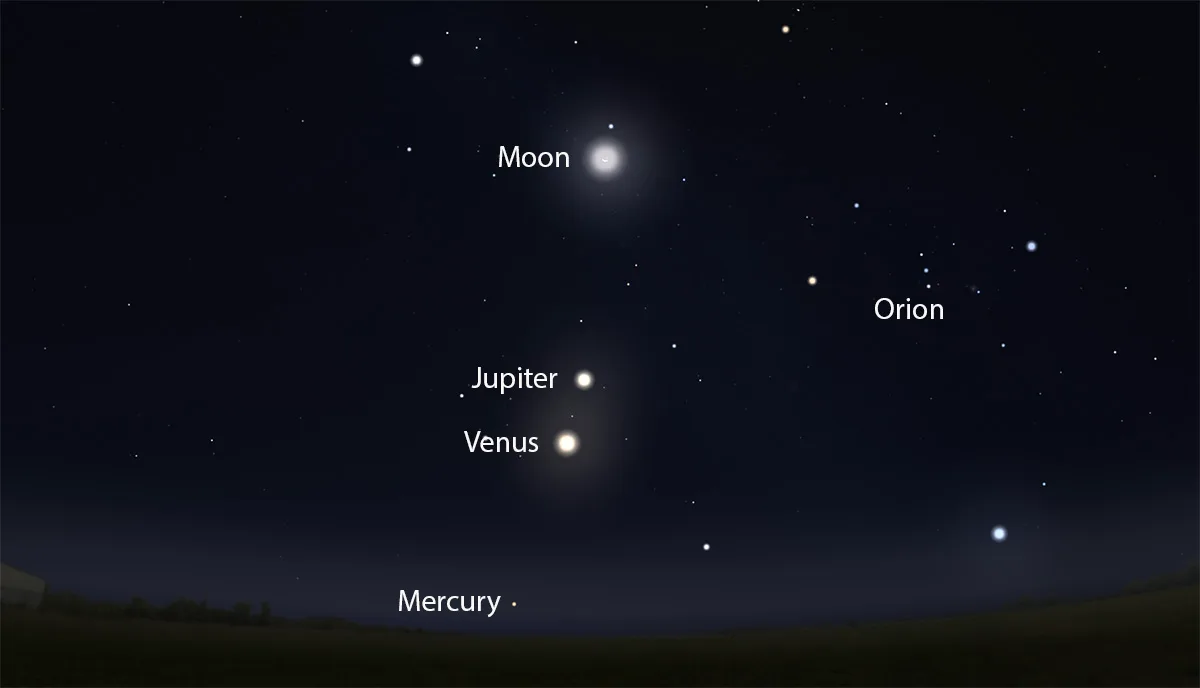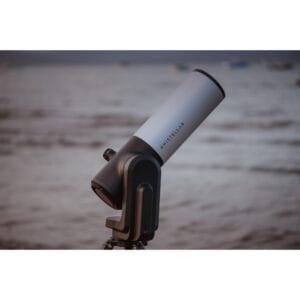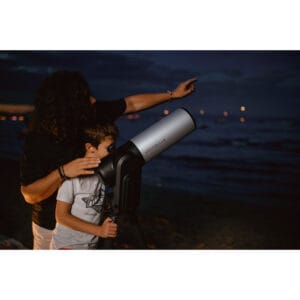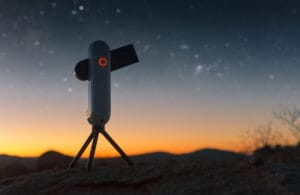The night sky in August 2025 is exceptionally interesting this year for anyone who enjoys looking up. Not only because the summer months offer warm, clear nights, but also due to a special planet parade where six planets are visible simultaneously. Add to that the annual Perseid meteor shower and you have one of the most beautiful months of the year for observers.
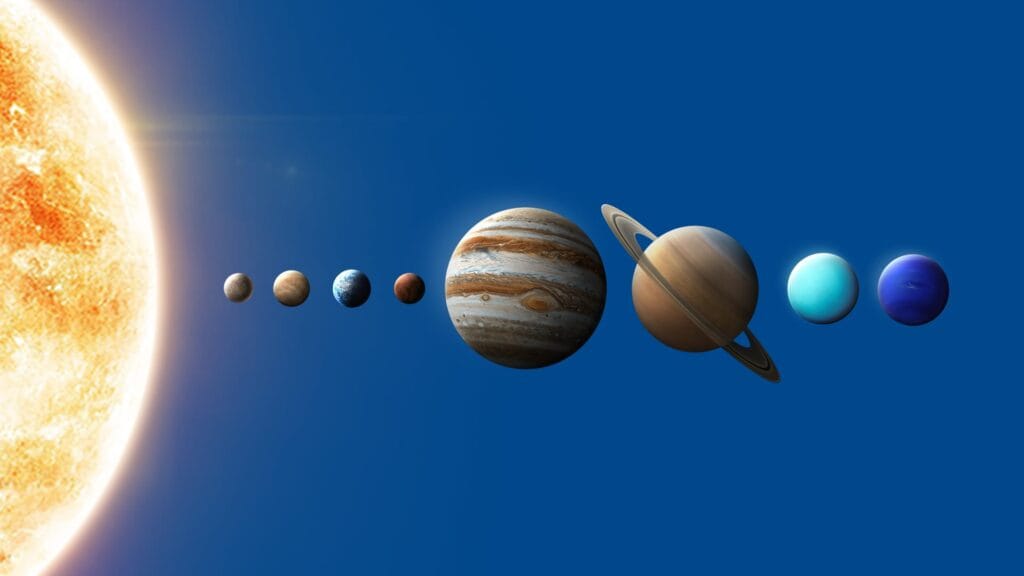
Whether you’re a beginner observing with the naked eye, or someone who has just acquired a telescope or wants to purchase one: August 2025 offers a wealth of celestial phenomena for every level.
Night Sky August 2025: What’s there to See?
In August, the Milky Way stands prominently high in the sky. From a dark location, the band-like ribbon of light from billions of stars is visible to the naked eye, an impressive sight that never bores even experienced observers.
The Summer Triangle formed by the bright stars Vega (Lyra), Deneb (Cygnus), and Altair (Aquila) dominates the night sky. These three stars serve as a handy guide: once you’ve found them, you can easily navigate to other objects. Or use an app like Stellarium.
In the south, low above the horizon in August 2025, lie the richest areas of the Milky Way: the center of our galaxy in the constellation Sagittarius. Here you’ll find spectacular nebulae and star clusters such as:
- The Lagoon Nebula (M8)
- The Trifid Nebula (M20)
- The Omega or Swan Nebula (M17)
With a small telescope or binoculars, you can already see them as faint patches, but in a large telescope details become visible.
Suggestions for Beginning Observers
- Find a dark location outside the city and give your eyes 20 minutes to adjust to the dark.
- Use a simple planisphere or an app to recognize constellations.
- Try using binoculars or invest in a telescope. Many deep-sky objects are already visible this way.
Planet Parade August 2025: Six Planets Visible Simultaneously
The biggest news for August 2025 is undoubtedly the planet parade. Just before sunrise, you can see no less than six planets simultaneously in the sky: Venus, Jupiter, Saturn, Mercury, Uranus, and Neptune.
Which Planets are Visible and how Can You See Them?
- Where and when: Bright in the east, around 04:30 / 05:30.
- How to observe: Visible to the naked eye as a brilliant “morning star”. With a telescope, you can see Venus’s phase, like looking at a miniature moon.
- Where and when: Close to Venus, slightly lower on the horizon.
- How to observe: Already visible to the naked eye as a bright star. With a small telescope or good binoculars, you can see the four largest moons (Io, Europa, Ganymede, Callisto) as points of light around the planet.
- Where and when: Visible all night in the south and still well visible around sunrise.
- How to observe: Visible to the naked eye as a bright, yellow star. Through a telescope, the ring structure reveals itself, one of the most impressive sights you can see.
- Where and when: From around August 18, low in the east, just before sunrise.
- How to observe: Mercury is small and fast. Look shortly before sunrise and ensure a clear horizon. A telescope makes it clearly visible as a small disk.
- Where and when: Both planets are only visible with a telescope, low above the horizon in the east.
- How to observe: Use a star guide or app to find their exact position.
Fortunately, we have written a blog for each planet explaining how to best observe them. Click on the planet’s name and you’ll be redirected to a blog where we explain in detail which telescope you can use to view the planet.
Tip: Use an app like Stellarium to easily find them. Don’t want to download an app? Use this live map.
Best Times for the Planet Parade
- August 12: Venus and Jupiter are closest together.
- August 12-20: All six planets are visible before sunrise, provided the horizon is clear and the sky is transparent.
A small telescope like a 70mm refractor is already enough to discover the main details of Venus, Jupiter, and Saturn. Did you know that light pollution doesn’t affect planets? This is because planets in our solar system are much brighter than faint deep-sky objects. They reflect sunlight and therefore stand out sharply against the background sky, even in a city with lots of artificial light.
Night Sky August 2025: Perseid Meteor Shower and other Highlights
Besides the planets, August is famous for the Perseids.
When: The peak occurs around the night of August 12-13.
What to expect:
- Many shooting stars per hour under ideal conditions, but don’t expect too much.
- No equipment needed; just lie down and look up.
Other highlights:
- New Moon: In the first week of August. Perfect for deep-sky objects.
- Full Moon: In the last week of August, ideal for moon craters and details along the terminator.
Best Way to Observe in August
- Choose a dark location: Avoid artificial light. National parks or the Wadden Islands are favorites in the Netherlands.
- Plan ahead: Check a star map beforehand to see where planets are located. An app like Stellarium helps.
- Use the right tools:
- With naked eye: Perseids and the bright planets.
- With binoculars: Star clusters and nebulae like M13 or M31 (Andromeda Galaxy).
- With a telescope: Details of Saturn, Jupiter and deep-sky objects. See also our telescope buying guide.
Which Telescope is Right for You?
Many people discover during such a month how beautiful it is to look at the sky themselves. If you want to do more after August, consider:
- For beginners: A simple Dobsonian telescope (for example, a 130 or 150 mm). Easy to operate and lots of observing power.
- For those who like assistance: The StarSense explorer line from Celestron helps you with an app, and you look live through the eyepiece. A smart telescope like the Seestar S50 or Dwarf 3, which automatically finds and tracks objects. Less suitable for planets
- For astrophotography: A small apochromatic refractor with a tracking mount.
On our website, you’ll find a comprehensive buying guide where we explain step by step which telescope suits your way of observing.
Are you just starting out and want to learn to discover on your own? Then we often recommend a simple Dobsonian – robust, affordable, and ideal for mastering the basics.
If you prefer app assistance in finding objects, you’ll likely end up with Celestron’s StarSense Explorer models: you search the sky yourself but get clear guidance.
And if you prefer fully automatic viewing and photography, you can switch to a smart telescope like the Seestar S50 or Dwarf 3, which automatically locates and tracks objects so you can focus on the image.
Learn more and Plan Ahead
Want more in-depth information? We publish a monthly overview of what’s visible, no newsletter subscriptions, no spam, simply keep an eye on our blog page at the end of each month.
Conclusion
The night sky in August 2025 offers a unique combination: an impressive planet parade, the Perseids, and beautiful deep-sky objects. Whether you’re observing with the naked eye, using binoculars, or wanting to buy your first telescope, this month is THE moment to explore the night sky.
This is the time to start stargazing.
Use August to discover what interests you most and prepare for a season full of discoveries. Visit our webshop and find the right telescope to see the planet parade, Jupiter’s moons, and Saturn’s rings up close.

